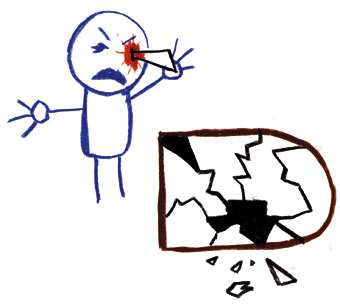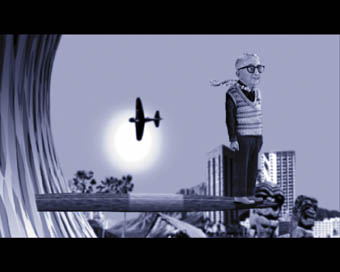The view from the child
Keith Gallasch

Shhh…
It’s curious how often a bunch of film finalists can display striking thematic similarities although stylistically they work in very different ways. Without having access to the rest of the short animation field for these awards it’s hard to tell if you’ve witnessed a trend or a manifestation of the unconscious desires of the judges who made the final selection. Whatever, these films shared as their subject the evocation of childhood subjectivity—whether recollected, in first or third person, intimately or ironically—with some very interesting visual outcomes.
Into the Dark (6 minutes; also short-listed for this year’s Dendy Awards) is a brief moment-of-death reverie strung tautly between the poles of guilt (a boy shoots a bird in a huge backyard tree) and pleasure (the boy’s imagined moments of naked flight, lifting off from a pool of water on a bathroom floor). The shooting of the bird has a furtive quality, mostly done in a detached, objectifying silhouette, while the sustained bathroom scene has a pronounced sense of interiority. It commences from the boy’s point of view with the sharp black and yellow of the bathroom seen through watery distortion, one of the best graphic moments of the film. This subjectivity, reinforced by first person narration, alternates with another identification strategy as we find ourselves face to face with the boy, leisurely and sensually towelling himself dry, or about to float up. The firmness of line in the bathroom scenes contrasts with the smudged charcoal rawness of the journey to death on a hospital gurney, our only point of view that of the dying man. The operating theatre staff are giant silhouetted birds, there is a stoush with a dog. In the bathroom, the boy flies, but the dog and birds fight outside and a small bird, like the one the boy shot, flails and thumps like a giant against the window. The oscilloscope beep of life drains away into a sustained signal of death. The frame is filled with the same deep sepia photograph of a boy we encountered eye to eye as the film opened. The inclusion of the dog aside (a role never firmly established, you feel you might have missed something), Into the Dark is demanding, placing the viewer in an intensely subjective position while feeling at all times that this is someone else’s life. On second viewing I was less than happy with the use of the photograph with its suggestion of biographical reality and of time long past. The animation can stand on its own without this. In terms of manipulation of point of view and the merging of visual styles, Into the Dark manages to be both pleasingly coherent and nightmarish: a common childhood act staying, like original sin, with its perpetrator until death.
The wickedly inventive Sssh… (5 mins), is in no doubt that all human ills are born with us, or at least that’s how it can feel when a baby cries despite every attempt at consolation. This time the view is determinedly adult though that’s a position the film plays with very cleverly. The great thing about Ssssh… is not just its virtuosity and wit, but the framing of its lateral narrative. A baby drawn onto the screen by the filmed hand of the animator cries raucously and endlessly. The animator rapidly provides numerous, hilarious solutions (most playing with cartoon animation transformations) but none is effective—the companionship of another baby briskly sketched in yields 2 screaming kids, all mouths, and brutal erasure of the newcomer. The baby is spun around, the artist’s nib opens the back of the head and we are plunged into baby-world-view. Slick, lively Chuck Jones style animation is suddenly supplanted with aggressive animated stick drawings of all kinds of mayhem, funny and increasingly grim, including a potted history of the attempted genocide of Aborigines (the blood around the base of an Australian flag pole briskly cleaned up in an act of ‘forgetting’). The incision is bandaided and baby calmed. In contrast to reflective, lyrical animations with metaphyiscal musings, it was a pleasure to see an animation with political drive, focussed inventiveness, satirical wit and a vigorous playfulness with its own conventions. The switch to the style of children’s drawings is a bold one that works well, a rough ride from innocence to experience.

Neil Goodridge, Pa
Pa (6 mins) starts out innocuously with an actress playing Grandma working her way through her huge collection of photographs, including many of her husband, Pa, while a boy’s voiceover informs us that the grandson never met his grandfather. The animation proper commences with a photograph of Pa’s grave, the site sprouting colourful flowers as the boy recalls his imaginings of what Pa might have been like from the odd bits of information he has gleaned. And it’s then that the film springs to life in its dextrous collaging and creative distortion of largely black and white photographic images that conjure Pa’s fantastic world. While reminiscent of, among others, Terry Gilliam working on Monty Python, director Neil Goodridge’s handling of the collage style is taut, consistent and makes the most of the juxtapositions the form allows while keeping the narration simple—the relative innocence of the words up against the heightened imagery. The boy fuses Pa’s love of chooks with his passion for cricket, and so conjures a cricket match played by Pa and his chooks in cricket gear, chooks watching from the the grandstand, and Pa beheading his team mates as his bat becomes an axe. Similarly a love of fish collecting and walks in the bush merge into a fantastic journey astride a huge fish through a forest. And it gets wilder, and wittier—Pa milking a snake as if it were a cow and spiking a guest’s drink with the poison. Pa, the canary fancier, joining the bird on its swing. Pa dreaming of going to Hawaii, the boy imagining him as surfing a huge wave (a striking scene) until he crashes, falling prey to cancer. We sense behind these astonishing visions a man who enjoyed many rather ordinary passions, but who was also a bit of character, and is sorely missed by the grandson who never knew him, hence the power of family lore and the photograph album. The film’s opening, with the grandmother, and its ending, with the face of the boy popping out of the head of the canary, are cumbersome and twee devices for a film of, otherwise, such drive, threatening to throw off-balance the engaging play of toughness and whimsy. As in Sssh… there was also a nice sense of the film emerging from our own culture.
Strangely, after the delights of familiar graphic forms, the 3D computer animation of Mark Gravas’ Show and Tell (5 mins) seemed almost traditional, so familiar and commercial has the style become. It’s set in a futuro-gothic, out-sized classroom juxtaposed with a richly coloured world of child fantasies, those of a despised boy who collects junk on his way to school and uses it as the subject of his show-and-tell. The rhyming couplet narration (adult, third person) nicely matches the boy’s growing success as he seduces the class (and demolishes his teacher) with a tale of a magical journey to “the mutant bat’s grave”, while producing from his bag mattress springs, roadkill and a one-legged dog called Max. It’s all too easy a journey to success, the teacher is a cliché, the dog under-used, but it has a nice, droll fabulist’s sense of wicked inevitability, expertly realised figures and a marvellously vertiginous play with perspectives.
The 5th contender Dad’s Clock (writer-director Dik Jarman; RT 50, p24) didn’t make it into the final 4. It’s an expertly crafted, melancholic reverie that juxtaposes a simple narrative told by the son of a dying father, with images of the man’s fantasy construction of a fantastic boat. Dad’s Clock is as expertly crafted as any of the above animations and shares not a few similarities in theme.
If these animations are indications of the health of the art, then there is no shortage of really expert craft, seriousness that transcends whimsy and a great capacity to play with psychological and visual point of view. In the end it was the feverish wit, visual inventiveness, lateral narrativity and political edginess of Shhh… that won me.
Into the Dark, writer-director Dennis Tupicoff, producers Fiona Cochrane, Dennis Tupicoff; Shhh…, writer-director Adam Robb, producers Paul Fletcher, Andi Spark; Pa, writer-director Neil Goodridge, producer Andrew McVitty; Show and Tell, director Mark Gravas, writers Bradley Trevor Grieve, Sandra Walters, producer Sandra Walters.
RealTime issue #51 Oct-Nov 2002 pg. 29






